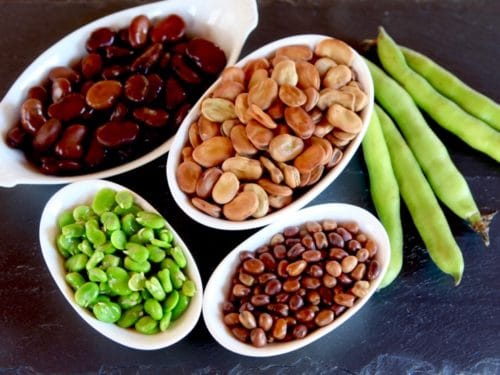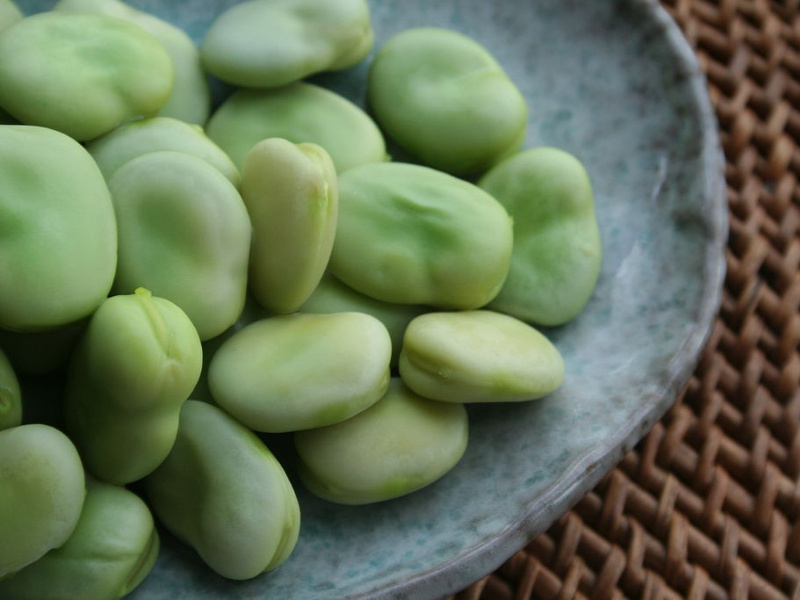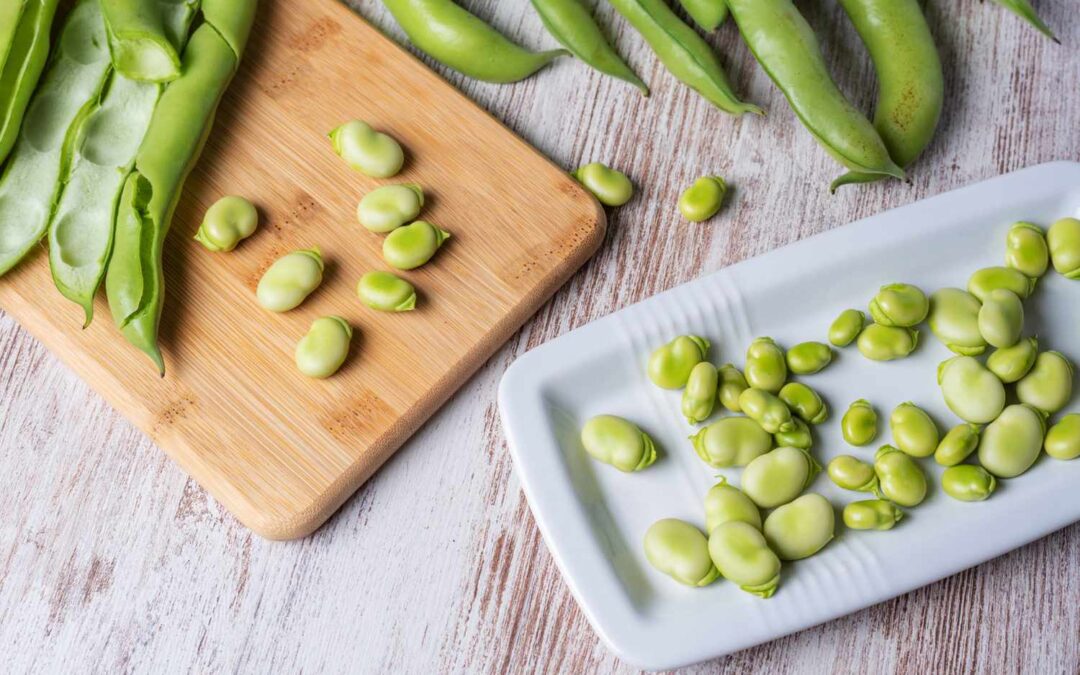Fava Beans:
Fava beans, also known as broad beans, are a type of legume that belongs to the Fabaceae family. These beans have a unique taste and are widely consumed in various cuisines around the world. Here are some key points about fava beans:
Characteristics of Fava Beans:
Botanical Name: Fava beans are scientifically known as Vicia faba.
Physical Characteristics: Fava beans are large, flat, and broad. They have a firm texture and are typically light green in color. The beans are encased in thick, slightly fuzzy pods.
Culinary Uses: Fava beans are used in a variety of dishes. They can be enjoyed on their own as a side dish, added to salads, soups, stews, and pasta dishes. In some cuisines, they are pureed and used in dips or spreads.
Nutritional Value: Fava beans are a good source of protein, dietary fiber, and various vitamins and minerals. They are particularly rich in folate, manganese, phosphorus, and magnesium.
Salads: Fresh fava beans are often used in salads, providing a burst of green color and a crisp texture.
Purees and Dips: Cooked fava beans can be pureed to make dips or spreads, such as the traditional Middle Eastern dish, ful medames.
Soups and Stews: Fava beans are used in various soups and stews around the world, adding both flavor and nutritional value.
Sautéed or Stir-Fried: Fava beans can be sautéed or stir-fried with other vegetables and herbs for a tasty side dish.
Snacking: In some cultures, young and tender fava beans may be enjoyed as a snack, either roasted or boiled.
Note of Caution:
Fava beans contain a compound called vicine, which can be harmful to individuals with a genetic condition called favism. Favism is an inherited disorder that can cause a severe reaction to eating fava beans, leading to symptoms such as hemolytic anemia. People with favism should avoid consuming fava beans.
As with any food, individual reactions and dietary considerations can vary, so it’s essential to be aware of personal health conditions and consult with a healthcare professional or a registered dietitian if needed.
Fava Beans in Urdu:
In Urdu, fava beans are called “بھٹ” (pronounced as “bhat”). “فاوا پھلیاں” is the Urdu translation for “fava beans.” The pronunciation is similar to “fava phallian” where “phallian” refers to beans or legumes in general.
Fava Beans Recipe:
Ingredients:
1 cup fresh fava beans (removed from pods)
1 tablespoon olive oil
2 cloves garlic, minced
Salt and pepper to taste
Lemon wedges for garnish
Instructions:
Remove the fava beans from their pods. If the beans are large, you may also want to remove the tough outer skin by blanching them in hot water for a minute and then transferring them to ice water. The skin should then be easy to peel off.
Heat olive oil in a pan over medium heat. Add minced garlic and sauté until fragrant.
Add the fava beans to the pan and stir-fry for about 5-7 minutes until they are tender but still have a slight crunch.
Season with salt and pepper to taste.
Serve the fava beans hot, garnished with lemon wedges.
Fava beans protein
Fava beans are a good source of plant-based protein. One cup of cooked fava beans provides approximately 13 grams of protein. Including fava beans in your diet can contribute to meeting your protein needs, especially if you follow a vegetarian or vegan diet.
Fava beans side effects
While fava beans are generally considered safe for most people, there are a few considerations:
Favism: Some individuals have a genetic condition called favism, and consuming fava beans can trigger symptoms such as hemolytic anemia in these individuals. People with favism should avoid fava beans.
G6PD Deficiency: Favism is associated with a deficiency of the enzyme glucose-6-phosphate dehydrogenase (G6PD). If you have G6PD deficiency, it’s important to be cautious with fava bean consumption.
Flatulence: Like many legumes, fava beans can cause gas and bloating in some people due to their complex carbohydrates. Gradual introduction and proper cooking methods can help reduce these effects.
As with any food, it’s advisable to consume fava beans in moderation, especially if you have specific health conditions or concerns. If you have any doubts or health issues, it’s recommended to consult with a healthcare professional.
Fava Beans Nutrition:
Here’s the approximate nutritional content of fava beans per 100 grams:
Calories: 88 kcal
Protein: 5.4 g
Carbohydrates: 18.3 g
Dietary Fiber: 8 g
Sugars: 8 g
Fat: 0.6 g
Saturated Fat: 0.1 g
Monounsaturated Fat: 0.1 g
Polyunsaturated Fat: 0.2 g
Vitamins and Minerals:
- Folate (Vitamin B9): 106 mcg (27% of the Daily Value)
- Vitamin C: 1.4 mg (2% of the Daily Value)
- Vitamin K: 1.8 mcg (2% of the Daily Value)
- Thiamine (Vitamin B1): 0.2 mg (10% of the Daily Value)
- Riboflavin (Vitamin B2): 0.1 mg (5% of the Daily Value)
- Niacin (Vitamin B3): 0.5 mg (3% of the Daily Value)
- Vitamin B6: 0.1 mg (6% of the Daily Value)
- Pantothenic Acid (Vitamin B5): 0.1 mg (1% of the Daily Value)
- Calcium: 33 mg (3% of the Daily Value)
- Iron: 1.5 mg (8% of the Daily Value)
- Magnesium: 21 mg (5% of the Daily Value)
- Phosphorus: 108 mg (11% of the Daily Value)
- Potassium: 299 mg (9% of the Daily Value)
- Sodium: 13 mg (1% of the Daily Value)
- Zinc: 0.6 mg (4% of the Daily Value)
- Manganese: 0.4 mg (19% of the Daily Value)
- Copper: 0.1 mg (6% of the Daily Value)
Fava Beans Other Names:
Broad Beans: Fava beans are often referred to as broad beans due to their large and flat appearance.
Vicia Faba: This is the botanical name for fava beans.
Fava Beans Benefits:
Rich in Nutrients: Fava beans are a good source of various essential nutrients, including protein, fiber, folate, iron, and manganese.
Heart Health: The fiber, potassium, and folate in fava beans may contribute to heart health by helping regulate blood pressure and reducing the risk of cardiovascular diseases.
Blood Sugar Regulation: The high fiber content in fava beans can help stabilize blood sugar levels, making them a good choice for individuals with diabetes.
Iron Content: Fava beans contain iron, which is essential for the formation of red blood cells and the prevention of iron-deficiency anemia.
Weight Management: The combination of protein and fiber in fava beans can contribute to a feeling of fullness, aiding in weight management.

Fava Beans and Cancer:
Fava beans, like many other legumes, contain certain compounds that may have potential anti-cancer properties. These compounds include phytochemicals and antioxidants that are being studied for their role in cancer prevention. However, it’s important to note that while a diet rich in fruits, vegetables, and legumes is generally associated with a lower risk of certain cancers, individual foods alone cannot guarantee the prevention or treatment of cancer. A balanced and varied diet, along with other healthy lifestyle choices, is recommended for overall well-being.
As always, if you have specific health concerns or conditions, it’s advisable to consult with a healthcare professional or a registered dietitian for personalized advice.
Fava Beans Benefits for Hair:
While fava beans are not specifically renowned for promoting hair health, their nutritional content may indirectly contribute to overall well-being, which can include benefits for hair. Fava beans contain various nutrients that are important for overall health, and a balanced diet supports healthy hair growth. Nutrients such as iron, zinc, protein, and vitamins (like biotin and folate) are known to play a role in maintaining healthy hair.
Fava Beans Calories:
One cup of cooked fava beans provides approximately 180 calories. While fava beans are nutritious, it’s essential to consider the overall caloric intake as part of a balanced diet.
Fava Beans Medical:
Fava beans have been studied for potential health benefits and medical applications. Some of the areas of interest include:
Antioxidant Properties: Fava beans contain antioxidants that may help combat oxidative stress in the body.
Heart Health: The fiber, potassium, and folate in fava beans may contribute to heart health by helping regulate blood pressure and reduce the risk of cardiovascular diseases.
Blood Sugar Regulation: The high fiber content in fava beans may assist in stabilizing blood sugar levels, making them a potential food choice for individuals with diabetes.
Iron Content: Fava beans are a source of iron, which is essential for preventing iron-deficiency anemia.
It’s important to note that while fava beans have potential health benefits, individual responses can vary, and specific medical conditions may require tailored dietary recommendations. Consultation with a healthcare professional or a registered dietitian is advisable, especially if you have specific health concerns or conditions.
Fava Beans Uses:
Fava beans can be used in various culinary applications, including:
Salads: Fresh fava beans can be used in salads for a fresh and nutritious addition.
Purees and Dips: Cooked fava beans can be blended into purees or dips, such as the traditional Middle Eastern dish, ful medames.
Soups and Stews: Fava beans are commonly used in soups and stews, adding both flavor and nutritional value.
Sautéed or Stir-Fried: Fava beans can be sautéed or stir-fried with other vegetables and herbs for a tasty side dish.
Remember that moderation is key, and a diverse diet that includes a variety of foods is essential for overall health. If you have specific health concerns or conditions, it’s recommended to consult with a healthcare professional or a registered dietitian for personalized advice.
Fava Beans Vitamins:
Fava beans are a good source of various vitamins, including:
Folate (Vitamin B9): Folate is important for DNA synthesis and cell division. One cup of cooked fava beans provides a significant amount of folate, contributing to the recommended daily intake.
Vitamin C: Fava beans contain vitamin C, which is an antioxidant that supports the immune system, helps the body absorb iron, and promotes healthy skin.
Thiamine (Vitamin B1): Thiamine is essential for converting carbohydrates into energy. Fava beans provide a small but notable amount of thiamine.
Riboflavin (Vitamin B2): Riboflavin is important for energy production and the metabolism of fats. Fava beans contain a modest amount of riboflavin.
Niacin (Vitamin B3): Niacin is involved in energy metabolism and DNA repair. Fava beans contribute a small amount of niacin to the diet.
Fava Beans Boiled:
Boiling is a common method of cooking fava beans. Here’s a simple guide for boiling fava beans:
Remove from Pods: If using fresh fava beans, remove the beans from their pods.
Blanching (Optional): Some prefer to blanch the beans in hot water for about 1-2 minutes to make it easier to remove the outer skin.
Boiling: Bring a pot of water to a boil. Add the fava beans and cook for about 5-7 minutes until they are tender. The exact cooking time may vary, so test a bean for doneness.
Drain and Cool: Drain the boiled fava beans and transfer them to a bowl of cold water or an ice bath to stop the cooking process.
Boiled fava beans can be used in various recipes, including salads, soups, or enjoyed on their own with a sprinkle of salt and olive oil.

Fava Beans Soup:
Fava Bean Soup Recipe:
Ingredients:
1 cup boiled fava beans
1 onion, chopped
2 cloves garlic, minced
2 medium-sized potatoes, diced
4 cups vegetable or chicken broth
Salt and pepper to taste
Olive oil for drizzling
Fresh herbs for garnish (parsley, mint)
Instructions:
In a pot, sauté chopped onions and minced garlic in olive oil until softened.
Add diced potatoes and boiled fava beans to the pot.
Pour in the broth and bring the soup to a simmer. Cook until the potatoes are tender.
Season with salt and pepper to taste.
Serve the soup hot, drizzled with olive oil and garnished with fresh herbs.
Fava Beans Scientific Name:
The scientific name for fava beans is Vicia faba.
Fava Beans Disease:
There is a specific genetic condition associated with the consumption of fava beans known as “favism.” Favism is a type of hemolytic anemia that can occur in individuals with a hereditary deficiency of the enzyme glucose-6-phosphate dehydrogenase (G6PD). When individuals with G6PD deficiency consume fava beans, it can trigger the destruction of red blood cells, leading to symptoms such as fatigue, jaundice, and dark urine. Not everyone with G6PD deficiency will experience favism, and the severity of symptoms can vary.
It’s important for individuals with known G6PD deficiency to be cautious about consuming fava beans and other substances that could trigger hemolysis. If you suspect or have been diagnosed with G6PD deficiency, it’s advisable to consult with a healthcare professional for guidance on dietary considerations.
Fava Beans Dried:
Dried fava beans, like many other legumes, are available for culinary use. These dried beans need to be soaked before cooking to rehydrate them. The process typically involves rinsing the dried fava beans and then soaking them in water for several hours or overnight. Once they have absorbed enough water, they can be cooked using various methods, such as boiling or simmering, until they reach a tender consistency.
Dried fava beans can be used in recipes similar to fresh fava beans, including soups, stews, purees, and salads. Keep in mind that the cooking time for dried fava beans may be longer than that for fresh beans.
Fava Beans Types:
There are several types or varieties of fava beans, and they may vary in size, color, and flavor. Some common types include:
Broad Windsor: This is a popular large-seeded variety with broad and flat beans.
Aquadulce Claudia: Another large-seeded variety known for its early harvest.
The Sutton: A smaller-seeded variety with a more compact plant, suitable for smaller gardens.
Sweet Lorane: This is a smaller, sweet-tasting variety.
Witkiem Manita: A dwarf variety with smaller beans, suitable for smaller spaces.
The choice of fava bean type may depend on factors such as climate, available space, and personal preference for flavor and size. When purchasing seeds or plants, it’s helpful to choose varieties that are well-suited to your growing conditions.

